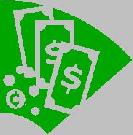
 |
|
| Financial Terms | |
| Balance of payments |
|
Information about financial, finance, business, accounting, payroll, inventory, investment, money, inventory control, stock trading, financial advisor, tax advisor, credit.
Main Page: business, inventory control, inventory, credit, payroll, accounting, finance, stock trading, |
Definition of Balance of payments
Balance of paymentsA statistical compilation formulated by a sovereign nation of all economic transactions Balance of PaymentsThe difference between the demand for and supply of a country's currency on the foreign exchange market.
Related Terms:Balance of Payments AccountsA statement of a country's transactions with other countries. Basic balanceIn a balance of payments, the basic balance is the net balance of the combination of the current Counterpart itemsIn the balance of payments, counterpart items are analogous to unrequited transfers in the Net errors and omissionsIn balance of payments accounting, net errors and omissions record the statistical Other capitalIn the balance of payments, other capital is a residual category that groups all the capital Unilateral transfersItems in the current account of the balance of payments of a country's accounting books  Capital AccountThat part of the balance of payments accounts that records demands for and supplies of a currency arising from purchases or sales of assets. Current AccountThat part of the balance of payments accounts that records demands for and supplies of a currency arising from activities that affect current income, namely imports, exports, investment income payments such as interest and dividends, and transfers such as gifts, pensions, and foreign aid. Official Settlements AccountAn account within the balance of payments accounts showing the change in a country's official foreign exchange reserves. It is used to measure a balance of payments deficit or surplus. SterilizationCentral bank action offsetting money supply changes automatically generated by a balance of payments surplus or deficit under a fixed exchange rate system. Balance of tradeNet flow of goods (exports minus imports) between countries. Balance sheetAlso called the statement of financial condition, it is a summary of the assets, liabilities, and Balance sheet exposureSee:accounting exposure. Balance sheet identityTotal Assets = Total Liabilities + Total Stockholders' Equity Balanced fundAn investment company that invests in stocks and bonds. The same as a balanced mutual fund.  Balanced mutual fundThis is a fund that buys common stock, preferred stock and bonds. The same as a Clearing House Automated Payments System (CHAPS)A computerized clearing system for sterling funds Clearing House Interbank Payments System (CHIPS)An international wire transfer system for high-value Compensating balanceAn excess balance that is left in a bank to provide indirect compensation for loans Coupon paymentsA bond's interest payments. Double-declining-balance depreciationMethod of accelerated depreciation. Interest paymentsContractual debt payments based on the coupon rate of interest and the principal amount. Lag response of prepaymentsThere is typically a lag of about three months between the time the weighted Net cash balanceBeginning cash balance plus cash receipts minus cash disbursements. Off-balance-sheet financingFinancing that is not shown as a liability in a company's balance sheet. Payments nettingReducing fund transfers between affiliates to only a netted amount. Netting can be done on  Payments patternescribes the lagged collection pattern of receivables, for instance the probability that a Prepaymentspayments made in excess of scheduled mortgage principal repayments. Receivables balance fractionsThe percentage of a month's sales that remain uncollected (and part of Remaining principal balanceThe amount of principal dollars remaining to be paid under the mortgage as of Target cash balanceOptimal amount of cash for a firm to hold, considering the trade-off between the Zero-balance account (ZBA)A checking account in which zero balance is maintained by transfers of funds BALANCE SHEETA “snapshot” statement that freezes a company on a particular day, like the last day of the year, and shows the balances in its asset, liability, and stockholders’ equity accounts. It’s governed by the formula: Declining balanceAn accelerated depreciation method that calculates depreciation each year by applying a fixed rate to the asset’s book (cost–accumulated depreciation) value. Depreciation stops when the asset’s book value reaches its salvage value. Balanced ScorecardA system of non-financial performance measurement that links innovation, customer and process measures to financial performance. Balance SheetA financial statement showing the financial position of a business – its assets, liabilities and Balance SheetOne of the basic financial statements; it lists the assets, liabilities, and equity accounts of the company. The balance Sheet is prepared using the balances at the end of a specific day. Declining-balanceA method of depreciation. Trial balanceA listing of all the accounts and their balances on a specified day. balance sheetA term often used instead of the more formal and correct balanced scorecard (BSC)an approach to performance Balance sheetA report that summarizes all assets, liabilities, and equity for a company balance sheetFinancial statement that shows the value of the common-size balance sheetbalance sheet that presents items as a percentage of total assets. market-value balance sheetFinancial statement that uses the market value of all assets and liabilities. zero-balance accountRegional bank account to which just enough funds are transferred daily to pay each day’s bills. Balance of Merchandise TradeThe difference between exports and imports of goods. Balance of TradeSee balance of merchandise trade. Balanced-Budget MultiplierThe multiplier associated with a change in government spending financed by an equal change in taxes. On-hand balanceThe quantity of inventory currently in stock, based on inventory Projected available balanceThe future planned balance of an inventory item, Balance SheetA financial report showing the status of a company's assets, liabilities, and owners' equity on a given date. Progress PaymentsPeriodic payments to a supplier, contractor or subcontractor for work satisfactorily performed to date. Graduated-payment mortgages (GPMs)A type of stepped-payment loan in which the borrower's payments Negative amortizationA loan repayment schedule in which the outstanding principal balance of the loan Price-specie-flow mechanismAdjustment mechanism under the classical gold standard whereby negative cash flowThe cash flow from the operating activities of a business Registered Retirement Savings Plan (Canada)Commonly referred to as an RRSP, this is a tax sheltered and tax deferred savings plan recognized by the Federal and Provincial tax authorities, whereby deposits are fully tax deductable in the year of deposit and fully taxable in the year of receipt. The ability to defer taxes on RRSP earnings allows one to save much faster than is ordinarily possible. The new rules which apply to RRSP's are that the holder of such a plan must convert it into income by the end of the year in which the holder turns age 69. The choices for conversion are to simply cash it in an pay full tax in the year of receipt, convert it to a RRIF and take a varying stream of income, paying tax on the amount received annually until the income is exhausted, or converting it into an annuity with guaranteed payments for a chosen number of years, again paying tax each year on moneys received. Related to : financial, finance, business, accounting, payroll, inventory, investment, money, inventory control, stock trading, financial advisor, tax advisor, credit. |